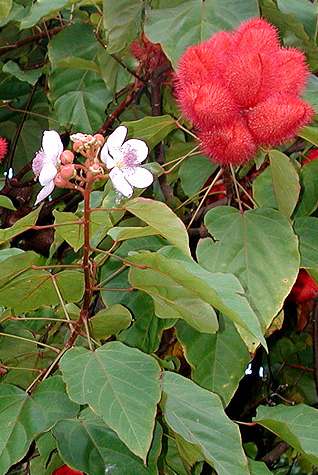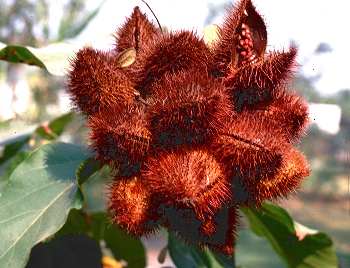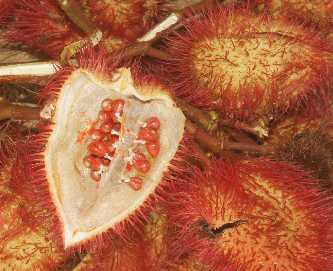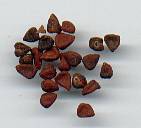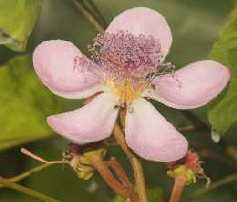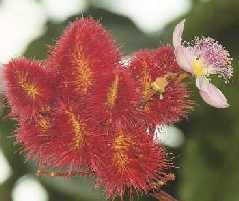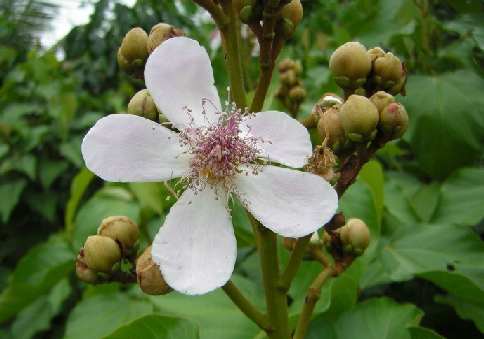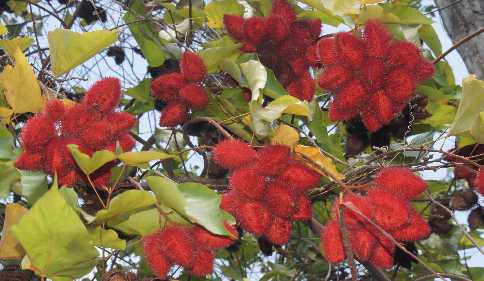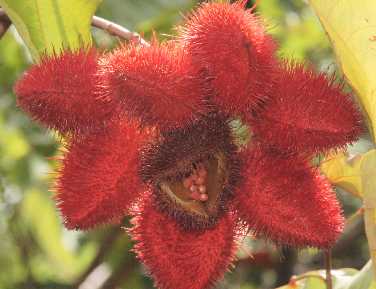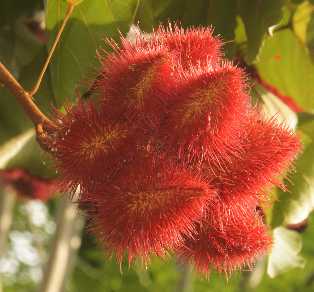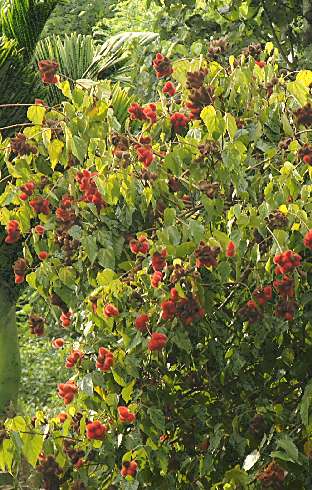
|
|
Annatto tree with ripe fruits
|
Annatto is native to South America, and is currently mostly
in use as a flavouring and food colouring in Central and Northern South
America. In the Caribbean, the seeds are usually fried in (animal or vegetable)
fat; after discarding the seeds, the then golden-yellow fat is used to fry
vegetables or meat. By this procedure, a golden yellow to golden brown colour
is achieved. Mexican cooks often use a paste (
achiote) of
annatto seeds with some preservatives (acetic acid) that dissolves completely
in hot fat; it is easy to use and can also be added to
marinades and sauces to improve the colour. Similar use is found in South America,
namely, Perú and Bolivia.
The original Aztec drinking chocolate (see also vanilla) is reported to have contained annatto seeds
as well; given their high fat content, this is entirely plausible, even more
since the crimson red colour bears associations with blood and thus had religious
connotations in Aztec society. Using
annatto to deepen the colour of chocolate was common in Europe until the 17.th
century; today, the spice has little if any significance and is used
occasionally to give butter and cheese a deep yellow colour (see also
blue fenugreek).
In South México (Yucatán), meat is often marinated
with a spice mixture called recado that derives
its vibrantly yellow colour from liberal addition of annatto. The annatto
seeds may be used ground (often after soaking in hot water to soften them)
or in form of annatto oil. Recado is made from annatto,
dried oregano, ground spices
(black pepper, allspice
and cumin), garlic
and fiery Yucatecan chiles. They key
flavour is the juice of bitter oranges (also known
as sour oranges or Seville oranges) which adds a distinct, acidic fruitiness.
|
|
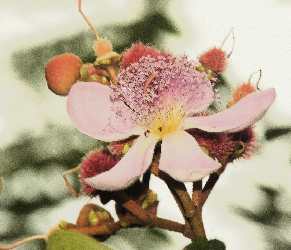
| |
Annatto flower
|
|
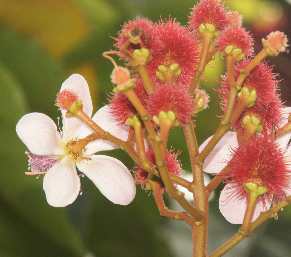
|
|
Annatto flower and immature pods
|
Recado‑marinated meats are wrapped in banana leaves and
baked in a hot stone pit. Baking in a hot oven, pan-frying or grilling is
also possible. The technique can be applied to poultry and fish, but is
most popular for pork, especially suckling pig. Food prepared this way
is generally referred to as pibil.
By Spanish influence, annatto also has made its way to South East Asia.
On the Philippines, the seeds are often ground to a powder and added to soups
and stews; meat is often marinated with annatto-coloured seasonings. The colour
obtained hereby is brownish–yellow, less vibrant than the colour resulting
from usage of annatto oil in the Caribbean. The nearby Mariana Islands also have
annatto seeds in their culinary repertoire; there, the fresh seeds are a component
in spice pastes and lend a deep crimson red colour to rice or pork dishes.

|
|
Annatto flower
|
Besides Philippino
cooking, the cuisines of South East Asia make little use of annatto seeds.
In Vietnam, batters are often prepared with annatto oil to achieve a more
attractive colour; annatto oil is also common for improving the colour of
coconut-based curries (ca ri [cà ri],
see rice paddy herb).
Lastly, there are Vietnamese varieties of Beijing duck
(ga quay mat ong [gà quay mật ong],
can be prepared with either duck or
chicken) that use annatto oil to colour the bird’s skin; Chinese cooks
produce a similar colour by treating the duck with malt solutions, which
caramelizes during baking. In China, annatto seeds are occasionally contained
in seasonings or marinades for grilled or fried meats
(predominantly pork), resulting in a bright orange meat surface.
Although some books state that annatto imparts its specific flavour to the food
stained therewith, I cannot myself agree with this opinion. It is true that
pure annatto seeds have same very faint fragrance, but this aroma is not
transmitted to the food. Yet fresh seeds are indeed a lot more aromatic (and also have
much better and redder colour), and it appears likely that annatto using cooks would go for
fresh seeds whenever the latter are available, even if cookbooks are silent on that issue. The only
cooking style of which I have confirmed knoledge that fresh seeds are used is the
Chamorro cooking from the Mariana Islands.
Orange or yellow hues can also be obtained with several other plants. A
chemically similar dye is contained in saffron, and
the colour may become quite similar; yet saffron with its incomparable
fragrance is much more than just a colouring agent. Safflower, in contrast, does not have any taste at
all and can, therefore, be used whenever colour is desired but no aroma wanted;
but its staining capability is low. Lastly, turmeric has a strong, earthy aroma and stains food
bright yellow.
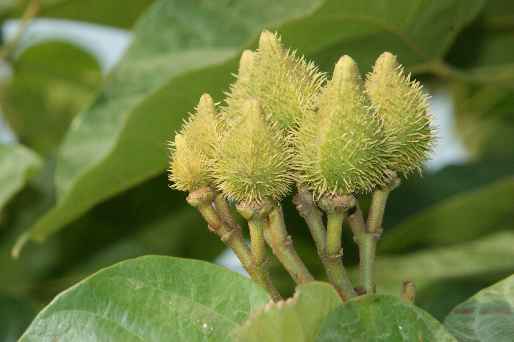
|
|
Unripe annatto pods
|
Both turmeric and saffron can even be used to dye textiles; both are,
however, not lightproof (and saffron is very expensive, though this usage is
mentioned in the Bible; see pomegranate).
Leaves can also be used to colour food, but, in general, they will give only a
modestly green colour (see pandanus leaves or mugwort for examples in Asian sweetmeats).
In the wild, leaf colours other than green are rare, but gardeners have
succeeded in breeding cultivars with red or otherwise coloured leaves from many
herbs and other plants (e. g., basil, sage or, most spectacularly, chameleon plant). In Japan, a purple-leaved variety of
perilla is used to colour pickled ginger.
The green leaf pigment chlorophyll is also responsible for the greenish
colour of some vegetable oils, namely olive oil
and pumpkin seed oil. Although the former is
usually too pale, the latter can be used to give both flavour and colour to
a variety of mostly cold foods.
There are no easy ways to achieve other colours with spices; several vegetables,
however, fortunately can fill this hole. Spinach is common for a bright green (because
it is more colourful than most other leaves), tomatoes for red, carrots for
orange and aubergines for purple. Italian cooks sometimes use the dark ink
of
squids to give their noodles (pasta) or rice dishes
(risotto) an exotic black colour.
Another, very unusual colouring agent is the dried cochenille bug, which gives
a bright and appealing pink (appalling though the culinary use of an insect may
seem). For those loathing beetles, the red beet is a viable and efficient
alternative.
Blue is the colour most difficult to achieve by natural dyes; people have tried
their luck with several flowers (e. g., borage), but
apart from being only seasonally available, none has proved sufficient
colouring capability. The best results are obtained with a plant from South
East Asia called butterfly pea (Clitoria ternatea,
Fabaceae), whose deep blue
coloured flowers have been used to colour desserts, particularly in
Thailand; but in our days, synthetic food dyes have become much more popular.

